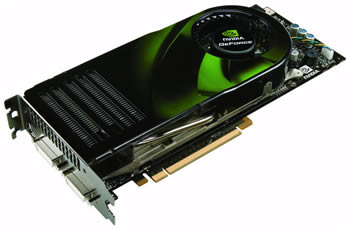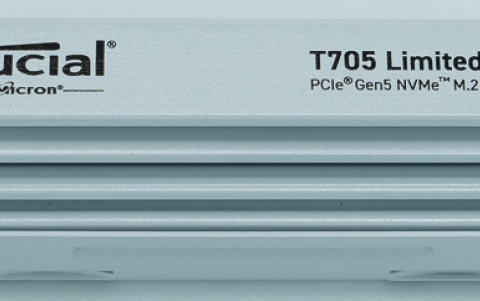
Nvidia Unveils GeForce 8800 GTX/GTS Graphics Cards
Nvidia has officially announced today its latest high-end solutions for PCI-Express x16 systems with SLI function. The GeForce 8800 GTX/GTS series represent the next generation of cards supporting DirectX 10 and Shader Model 4.0 standard which promise stunning graphics effects.
The flagship GeForce 8800 GTX GPU features 128 independent stream processors with shader clocks reaching 1.35 GHz, 768MB GDDR3 memory that interfaces with the GPU on a 384-bit bus and operating core and memory clock timings of 575 MHz and 1.8 GHz respectively.
Closely trailing its big brother is the GeForce 8800 GTS offers 96 stream processors pitched at 1.2 GHz, 640 MB GDDR3 memory in a 320-bit interface, a maximum 500 MHz core and 1.6 GHz memory clocks.

Incorporating NVIDIA's unified architecture technology, the GeForce 8800GTX and GeForce 8800GTS promise unprecedented processing power, performance, and precision using a single shader core for geometry, vertex, physics, and pixel shading operations. Using scores of stream processors, these cards promise twice the gaming performance versus older version GPUs while keeping compatibility and optimization for DirectX 9 applications. The new cards adopt Microsoft DirectX 10 and Shader Model 4.0 to offer unmatched display realism and render real-life, high-definition graphics complete with film-quality effects. These innovations enable developers to add more elements to game applications, such as better shadowing for more realism, and also make these graphics cards Windows Vista ready, including the sophisticated Windows Aero user interface.
The new graphics cards also carry a stockpile of NVIDIA's newest graphics support including GigaThread Technology, Lumenex engine, and Quantum Effects Technology. Operating with thousands of independent and parallel threads, GigaThread technology maximizes GPU utilization to achieve greater efficiency when processing next-generation shader programs. The Lumenex engine boasts 16 times anti-aliasing power, 128-bit floating point HDR (high-dynamic range), and agile frame rates for high-definition gaming and movie playback at the highest resolutions currently available on graphics card the market.
Meeting the industry's demand for physics effects, the cards come with NVIDIA Quantum Effects technology - a groundbreaking shader processor that delivers high-definition smoke, fire, or explosion effects and perfect fluid movements of game elements such as hair, fur, and water. This technology simulates and renders physics effects directly on the GPU, allowing the CPU to concentrate on the game engine and save precious processor energy.
Designed with two dual-link DVI connectors and HDTV-ready interface, the cards natively support two 2560 x 1600 resolution displays and support a variety of display devices including HDTVs, wide LCD monitors, and plasma displays.
In addition, these cards also support OpenGL 2.0 for compatibility with earlier OpenGL applications, and deploy a full suite of NVIDIA PureVideo Technology?an intelligent union of high-definition video decode acceleration and post-processing that brings smooth video playback, accurate colors, and precise image scaling.
DirectX 10 is the latest version of the DirectX standard developed by Microsoft Corporation and is used to give multimedia (graphics, communications, sound etc.) developers, namely the gaming industry, a more convenient and efficient interface (API) in developing application programs. In effect, developers get a very powerful environment to develop programs leading to more exciting games for consumers. The new DirectX 10 standard is used by and geared for the upcoming Windows Vista operating system which makes this release very timely as Microsoft readies its huge consumer Windows Vista release in early 2007. To take advantage of the latest games using DirectX 10 you will need to run on a system with Windows Vista and a DirectX 10 graphics subsystem. This new version supplants the Direct9.0c version and features a very robust feature set with significant improvements, especially in rendering complex 3D effects in real time. With DirectX 10 comes the new Shader Model 4.0 which also includes significant changes to the graphics processing, reducing idle time and increasing task sharing between shader models and generally making it much more efficient and faster.
Gaphics cards based on the GeForce 8800 GTX/GTS GPUs are currently available from Nvidia's parners Foxconn, Biostar, EVGA and many more.
Closely trailing its big brother is the GeForce 8800 GTS offers 96 stream processors pitched at 1.2 GHz, 640 MB GDDR3 memory in a 320-bit interface, a maximum 500 MHz core and 1.6 GHz memory clocks.

Incorporating NVIDIA's unified architecture technology, the GeForce 8800GTX and GeForce 8800GTS promise unprecedented processing power, performance, and precision using a single shader core for geometry, vertex, physics, and pixel shading operations. Using scores of stream processors, these cards promise twice the gaming performance versus older version GPUs while keeping compatibility and optimization for DirectX 9 applications. The new cards adopt Microsoft DirectX 10 and Shader Model 4.0 to offer unmatched display realism and render real-life, high-definition graphics complete with film-quality effects. These innovations enable developers to add more elements to game applications, such as better shadowing for more realism, and also make these graphics cards Windows Vista ready, including the sophisticated Windows Aero user interface.
The new graphics cards also carry a stockpile of NVIDIA's newest graphics support including GigaThread Technology, Lumenex engine, and Quantum Effects Technology. Operating with thousands of independent and parallel threads, GigaThread technology maximizes GPU utilization to achieve greater efficiency when processing next-generation shader programs. The Lumenex engine boasts 16 times anti-aliasing power, 128-bit floating point HDR (high-dynamic range), and agile frame rates for high-definition gaming and movie playback at the highest resolutions currently available on graphics card the market.
Meeting the industry's demand for physics effects, the cards come with NVIDIA Quantum Effects technology - a groundbreaking shader processor that delivers high-definition smoke, fire, or explosion effects and perfect fluid movements of game elements such as hair, fur, and water. This technology simulates and renders physics effects directly on the GPU, allowing the CPU to concentrate on the game engine and save precious processor energy.
Designed with two dual-link DVI connectors and HDTV-ready interface, the cards natively support two 2560 x 1600 resolution displays and support a variety of display devices including HDTVs, wide LCD monitors, and plasma displays.
In addition, these cards also support OpenGL 2.0 for compatibility with earlier OpenGL applications, and deploy a full suite of NVIDIA PureVideo Technology?an intelligent union of high-definition video decode acceleration and post-processing that brings smooth video playback, accurate colors, and precise image scaling.
DirectX 10 is the latest version of the DirectX standard developed by Microsoft Corporation and is used to give multimedia (graphics, communications, sound etc.) developers, namely the gaming industry, a more convenient and efficient interface (API) in developing application programs. In effect, developers get a very powerful environment to develop programs leading to more exciting games for consumers. The new DirectX 10 standard is used by and geared for the upcoming Windows Vista operating system which makes this release very timely as Microsoft readies its huge consumer Windows Vista release in early 2007. To take advantage of the latest games using DirectX 10 you will need to run on a system with Windows Vista and a DirectX 10 graphics subsystem. This new version supplants the Direct9.0c version and features a very robust feature set with significant improvements, especially in rendering complex 3D effects in real time. With DirectX 10 comes the new Shader Model 4.0 which also includes significant changes to the graphics processing, reducing idle time and increasing task sharing between shader models and generally making it much more efficient and faster.
Gaphics cards based on the GeForce 8800 GTX/GTS GPUs are currently available from Nvidia's parners Foxconn, Biostar, EVGA and many more.





















